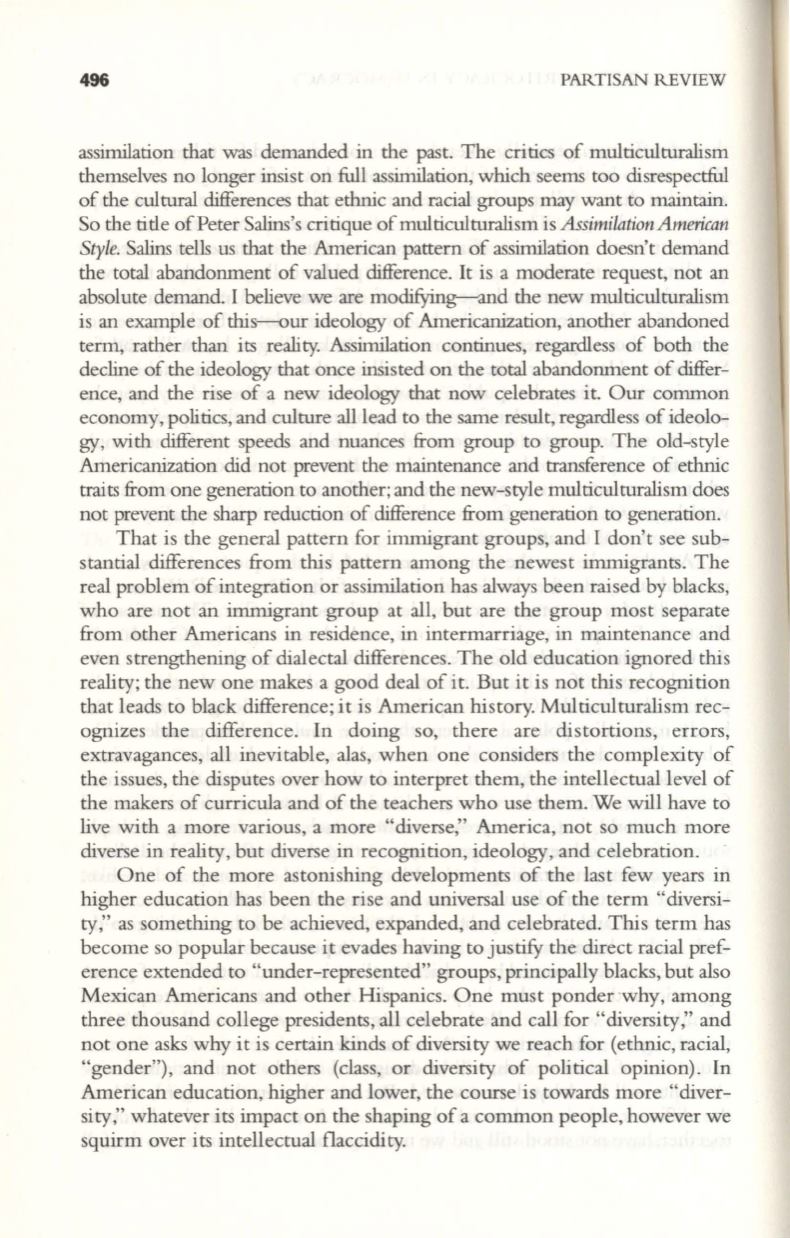
496
PARTISAN REVIEW
assimilation that was demanded in the past. The critics of multiculturalism
themselves no longer insist on full assimilation, which seems too disrespectful
of the cultural differences that ethnic and racial groups may want to maintain.
So the title of Peter Salins's critique ofmulticulturalism is
AssimiiationAmerican
Style.
Salins tells us that the American pattern of assimilation doesn't demand
the total abandonment of valued difference.
It
is a moderate request, not an
absolute demand. I believe we are modifying--and the new multiculturalism
is an example of this-our ideology of Americanization, another abandoned
term, rather than its reality. Assimilation continues, regardless of both the
decline of the ideology that once insisted on the total abandonment of differ–
ence, and the rise of a new ideology that now celebrates it. Our common
economy, politics, and culture all lead to the same result, regardless of ideolo–
gy, with different speeds and nuances from group to group. The old-style
Americanization did not prevent the maintenance and transference of ethnic
traits from one generation to another; and the new-style multiculturalism does
not prevent the sharp reduction of difference from generation to generation.
That is the general pattern for immigrant groups, and I don't see sub–
stantial differences from this pattern among the newest immigrants. The
real problem of integration or assimilation has always been raised by blacks,
who are not an immigrant group at all, but are the group most separate
from other Americans in residence, in intermarriage, in maintenance and
even strengthening of dialectal differences. The old education ignored this
reality; the new one makes a good deal of it. But it is not this recognition
that leads to black difference; it is American history. Multiculturalism rec–
ognizes the difference. In doing so, there are distortions, errors,
extravagances, all inevitable, alas, when one considers the complexity of
the issues, the disputes over how to interpret them, the intellectual level of
the makers of curricula and of the teachers who use them. We will have to
live with a more various, a more "diverse," America, not so much more
diverse in reality, but diverse in recognition, ideology, and celebration.
One of the more astonishing developments of the last few years in
higher education has been the rise and universal use of the term "diversi–
ty," as something to be achieved, expanded, and celebrated. This term has
become so popular because it evades having to justify the direct racial pref–
erence extended to "under-represented" groups, principally blacks, but also
Mexican Americans and other Hispanics. One must ponder 'why, among
three thousand college presidents, all celebrate and call for "diversity," and
not one asks why it is certain kinds of diversity we reach for (ethnic, racial,
"gender"), and not others (class, or diversity of political opinion). In
American education, higher and lower, the course is towards more "diver–
sity," whatever its impact on the shaping of a common people, however we
squirm over its intellectual flaccidity.


